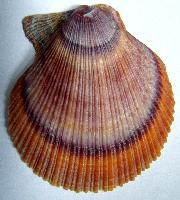
Váhy a míry
| Délka | 10 cm |
|---|
Popis zvířete
The Iceland scallop, scientifically known as Chlamys islandica, is a fascinating marine bivalve mollusk belonging to the family Pectinidae. This species is not only remarkable for its ecological role but also for its economic importance in the fisheries sector, particularly in the North Atlantic regions.Physically, the Iceland scallop exhibits a distinctive and aesthetically pleasing appearance. Its shell is typically rounded or slightly oval, adorned with radiating ribs that add to its structural integrity and beauty. The coloration of the shell can vary, presenting hues that range from creamy white to deeper oranges and pinks, often with a hint of other colors depending on the individual and its environment. The inside of the shell is usually glossy, showcasing a mother-of-pearl sheen that is both captivating and valuable.
The size of an Iceland scallop can vary, but individuals commonly reach a shell diameter of about 10 to 12 centimeters (4 to 4.7 inches). There are records of specimens growing much larger, making them one of the more sizable scallop species found in their natural habitats.
Iceland scallops are found in the cold waters of the North Atlantic, ranging from the eastern coast of North America to the coasts of Europe, including Iceland, which is central to their distribution and namesake. They prefer habitats that offer sandy or gravelly bottoms, where they can nestle and partially bury themselves for protection and feeding. These scallops are typically found at depths ranging from shallow waters to several hundred meters deep, demonstrating their adaptability to different marine environments.
The diet of the Iceland scallop consists mainly of plankton, which they filter from the water using their specialized gills. This mode of feeding is efficient and allows them to thrive in areas where plankton is abundant.
Reproduction in Iceland scallops involves the release of eggs and sperm into the water column, where fertilization occurs externally. This process usually takes place during the warmer months, leading to the seasonal dispersal of their larvae. The larvae are planktonic, drifting with the currents until they are developed enough to settle on the ocean floor, where they metamorphose into their adult form and begin their benthic lifestyle.
Economically, Iceland scallops are of significant value, particularly in regions where they are abundant. They are harvested both commercially and recreationally, with their meat being highly prized for its delicate flavor and tender texture. The fishing and management practices for Iceland scallops are subject to regulations designed to ensure the sustainability of their populations, as overfishing and habitat destruction pose ongoing threats.
Conservation efforts for the Iceland scallop focus on understanding their biology, habitat requirements, and the impacts of human activities on their populations. Research into their growth rates, reproductive cycles, and population dynamics is crucial for developing effective management strategies that can support both the species' conservation and the economic interests of the fisheries that depend on them.
In summary, the Iceland scallop is a marine bivalve of both ecological significance and economic value. Its presence in the North Atlantic ecosystems contributes to the biodiversity and function of these environments, while its harvest supports local economies. Understanding and protecting this species is essential for maintaining the balance between human use and the health of marine ecosystems.
Nové fotografie zvířat
Top 10 zvířat
- Chinese water dragon (Physignathus cocincinus)
- Galápagos tortoise (Geochelone nigra complex)
- Dolphin gull (Leucophaeus scoresbii)
- Japanese macaque (Macaca fuscata)
- Colombian red howler (Alouatta seniculus)
- Sea urchins (Echinoidea)
- Moustached guenon (Cercopithecus cephus)
- Diana monkey (Cercopithecus diana)
- Common reed warbler (Acrocephalus scirpaceus)
- Common house mosquito (Culex pipiens)